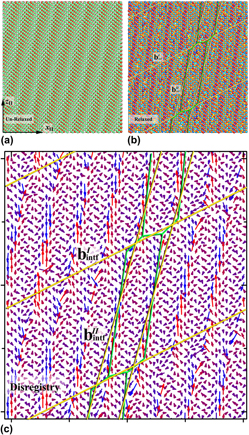Crossref Citations
This article has been cited by the following publications. This list is generated based on data provided by
Crossref.
Beyerlein, Irene J.
Wang, Jian
and
Zhang, Ruifeng
2013.
Mapping dislocation nucleation behavior from bimetal interfaces.
Acta Materialia,
Vol. 61,
Issue. 19,
p.
7488.
Shao, Shuai
Wang, Jian
Misra, Amit
and
Hoagland, Richard G.
2013.
Spiral Patterns of Dislocations at Nodes in (111) Semi-coherent FCC Interfaces.
Scientific Reports,
Vol. 3,
Issue. 1,
Beyerlein, Irene J.
Wang, Jian
and
Zhang, Ruifeng
2013.
Interface-dependent nucleation in nanostructured layered composites.
APL Materials,
Vol. 1,
Issue. 3,
Wang, J.
Beyerlein, I.J.
and
Tomé, C.N.
2014.
Reactions of lattice dislocations with grain boundaries in Mg: Implications on the micro scale from atomic-scale calculations.
International Journal of Plasticity,
Vol. 56,
Issue. ,
p.
156.
Shao, Shuai
Wang, Jian
Misra, Amit
and
Hoagland, Richard G.
2014.
Relaxation of Misfit Dislocations at Nodes.
Materials Science Forum,
Vol. 783-786,
Issue. ,
p.
515.
Salehinia, I.
Wang, J.
Bahr, D.F.
and
Zbib, H.M.
2014.
Molecular dynamics simulations of plastic deformation in Nb/NbC multilayers.
International Journal of Plasticity,
Vol. 59,
Issue. ,
p.
119.
Wang, Jian
Zhou, Caizhi
Beyerlein, Irene J.
and
Shao, Shuai
2014.
Modeling Interface-Dominated Mechanical Behavior of Nanolayered Crystalline Composites.
JOM,
Vol. 66,
Issue. 1,
p.
102.
Shao, Shuai
Wang, J.
and
Misra, Amit
2014.
Energy minimization mechanisms of semi-coherent interfaces.
Journal of Applied Physics,
Vol. 116,
Issue. 2,
Vattré, A. J.
Abdolrahim, N.
Kolluri, K.
and
Demkowicz, M. J.
2014.
Computational design of patterned interfaces using reduced order models.
Scientific Reports,
Vol. 4,
Issue. 1,
Salehinia, I.
Shao, S.
Wang, J.
and
Zbib, H. M.
2014.
Plastic Deformation of Metal/Ceramic Nanolayered Composites.
JOM,
Vol. 66,
Issue. 10,
p.
2078.
Wang, J.
Zhang, R.F.
Zhou, C.Z.
Beyerlein, I.J.
and
Misra, A.
2014.
Interface dislocation patterns and dislocation nucleation in face-centered-cubic and body-centered-cubic bicrystal interfaces.
International Journal of Plasticity,
Vol. 53,
Issue. ,
p.
40.
Zhang, R.F.
Germann, T.C.
Liu, X.-Y.
Wang, J.
and
Beyerlein, I.J.
2014.
Layer size effect on the shock compression behavior of fcc–bcc nanolaminates.
Acta Materialia,
Vol. 79,
Issue. ,
p.
74.
Yuryev, D. V.
and
Demkowicz, M. J.
2014.
Computational design of solid-state interfaces using O-lattice theory: An application to mitigating helium-induced damage.
Applied Physics Letters,
Vol. 105,
Issue. 22,
Shao, Shuai
Wang, Jian
Beyerlein, Irene J.
and
Misra, Amit
2015.
Glide dislocation nucleation from dislocation nodes at semi-coherent {1 1 1} Cu–Ni interfaces.
Acta Materialia,
Vol. 98,
Issue. ,
p.
206.
Beyerlein, I.J.
Demkowicz, M.J.
Misra, A.
and
Uberuaga, B.P.
2015.
Defect-interface interactions.
Progress in Materials Science,
Vol. 74,
Issue. ,
p.
125.
Salehinia, I.
Shao, S.
Wang, J.
and
Zbib, H.M.
2015.
Interface structure and the inception of plasticity in Nb/NbC nanolayered composites.
Acta Materialia,
Vol. 86,
Issue. ,
p.
331.
Zhang, R.F.
Beyerlein, I.J.
Zheng, S.J.
Zhang, S.H.
Stukowski, A.
and
Germann, T.C.
2016.
Manipulating dislocation nucleation and shear resistance of bimetal interfaces by atomic steps.
Acta Materialia,
Vol. 113,
Issue. ,
p.
194.
Liu, Y.
Li, N.
Shao, S.
Gong, M.
Wang, J.
McCabe, R. J.
Jiang, Y.
and
Tomé, C. N.
2016.
Characterizing the boundary lateral to the shear direction of deformation twins in magnesium.
Nature Communications,
Vol. 7,
Issue. 1,
Li, Nan
Demkowicz, Michael
Mara, Nathan
Wang, Yongqiang
and
Misra, Amit
2016.
Hardening due to Interfacial He Bubbles in Nanolayered Composites.
Materials Research Letters,
Vol. 4,
Issue. 2,
p.
75.
Kim, Jaemin
Kang, Keonwook
and
Ryu, Seunghwa
2016.
Characterization of the misfit dislocations at the ferrite/cementite interface in pearlitic steel: An atomistic simulation study.
International Journal of Plasticity,
Vol. 83,
Issue. ,
p.
302.
